| Zabius | |
|---|---|
 | |
| Scientific classification | |
| Kingdom: | |
| Phylum: | |
| Class: | |
| Order: | |
| Family: | |
| Genus: | Zabius Thorell, 1876 |
Zabius is a genus of scorpion in the family Buthidae. There are three species described in this genus. [1]
| Zabius | |
|---|---|
 | |
| Scientific classification | |
| Kingdom: | |
| Phylum: | |
| Class: | |
| Order: | |
| Family: | |
| Genus: | Zabius Thorell, 1876 |
Zabius is a genus of scorpion in the family Buthidae. There are three species described in this genus. [1]

The Buthidae are the largest family of scorpions, containing about 96 genera and over 1230 species as of 2021. A few very large genera are known, but a high number of species-poor or monotypic ones also exist. New taxa are being described at a rate of several new species per year. They have a [cosmopolitan] distribution throughout tropical and subtropical environments worldwide. Together with four other families, the Buthidae make up the superfamily Buthoidea. The family was established by Carl Ludwig Koch in 1837.

Centruroides is a genus of scorpions of the family Buthidae. Several North American species are known by the common vernacular name bark scorpion. Numerous species are extensively found throughout the southern United States, Mexico, Central America, the Antilles and northern South America. Some are known for their interesting patterning or large size ; most if not all fluoresce strongly under ultraviolet illumination, except after moulting. They contain several highly venomous species, and fatalities are known to occur. The venom of the Mexican scorpion Centruroides limpidus limpidus contains the neurotoxins Cll1 and Cll2.
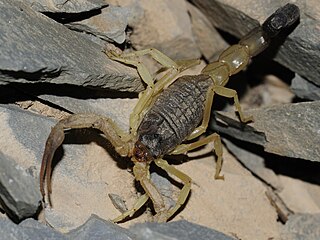
Hottentotta is a genus of scorpions of the family Buthidae. It is distributed widely across Africa, except for most of the Sahara desert. Species in the genus also occur in the Middle East, the Arabian Peninsula, southeastern Turkey, Iraq, Iran, Afghanistan, Pakistan, India, Nepal, Cape Verde Islands, and Sri Lanka (introduced).
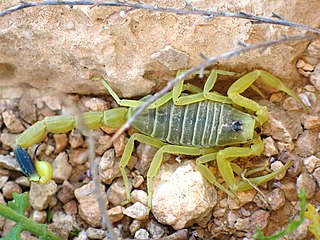
Leiurus is a genus of scorpion of the family Buthidae. The most common species, L. quinquestriatus, is also known under the common name Deathstalker. It is distributed widely across North Africa and the Middle East, including the western and southern Arabian Peninsula and southeastern Turkey. At least one species occurs in West Africa.
Uintascorpio is an extinct genus of scorpion in the family Buthidae and containing the single species Uintascorpio halandrasorum. The species is known only from the Middle Eocene Parachute Member, part of the Green River Formation, in the Piceance Creek Basin, Garfield County, northwestern Colorado, USA.
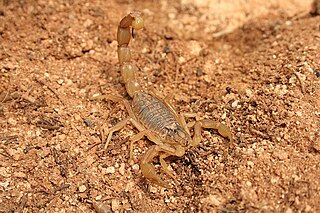
Buthus is a genus of scorpion belonging and being eponymous to the family Buthidae. It is distributed widely across northern Africa, including Morocco, Mauritania, Algeria, Tunisia, Libya, Egypt, Senegal, Guinea-Bissau, Nigeria, Sudan, Somalia, Ethiopia, Djibouti, as well as the Middle East, including Israel, Palestine, Jordan, Lebanon, Iraq, Yemen, and possibly Saudi Arabia and southern Turkey. Its European range includes the Iberian Peninsula, southern France, and Cyprus.

Zabius fuscus is a scorpion of the family Buthidae, and one of the three species in the genus Zabius. They can be found in the mountains of central Argentina, and in various cities that are located in the center of the country. The species are ghostly blue coloured. They prefer to live in deep crevices of large, half buried blocks or outcrops. Sometimes they might be found under stones. Just like any other scorpions they carry their young on their back.
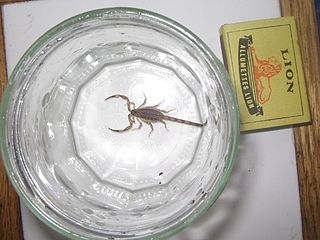
Isometrus is a genus of scorpion belonging and being eponymous to the family Buthidae. Some species are currently assigned to the genus Reddyanus.
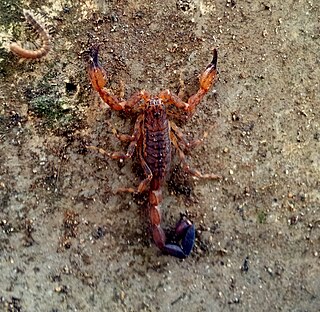
Reddyanus besucheti is a species of scorpion in the family Buthidae endemic to Sri Lanka.
Isometrus thwaitesi is a species of scorpion in the family Buthidae endemic to Sri Lanka.
Reddyanus loebli is a species of scorpion in the family Buthidae.
Mesobuthus is an Asian genus of scorpions in the family Buthidae.
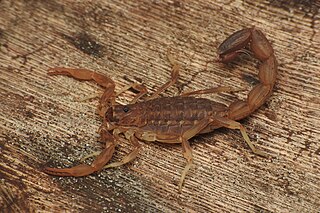
Lychas srilankensis is a species of scorpion in the family Buthidae. It is endemic to Sri Lanka.
Hottentotta finneganae is a species of scorpion, belonging to the family Buthidae. It was first found in Pakistan.
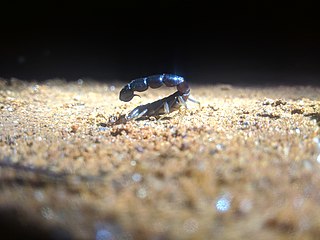
Buthoscorpio is a genus of scorpions in the family Buthidae.
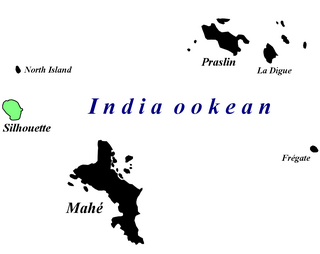
Afrolychas braueri, commonly known as the Seychelles forest scorpion, is a species of scorpion in the family Buthidae. It is currently thought to survive only on Silhouette Island, Seychelles, although the species was historically found on two additional Seychellois islands. This scorpion lives in leaf litter in forests that are largely unaffected by invasive plant species. It is a small yellowish-brown scorpion with three prominent keels on the dorsal surface of its mesosoma, which distinguishes it from other scorpions. While not much is known about the Seychelles forest scorpion's ecology due to the paucity of sightings, it is known to rely solely on its venom to capture its prey and defend its young. Its venom is not dangerous to humans.
Afrolychas is a genus of scorpion in the family Buthidae. There are two species in this genus, both of which used to belong to the genus Lychas. The genus was described in 2019 by František Kovařík. The genus name Afrolychas is a reference to the African range of its species and the fact that the two species used to be members of the genus Lychas. Afrolychas's closest relatives are believed to be the scorpions in the genus Pseudolychas. Afrolychas braueri is one of the rarest scorpions in the world, as it is listed as critically endangered on the IUCN Red List.
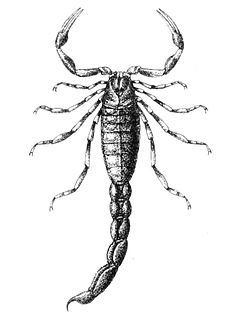
Charmus is a genus of buthid scorpions native to India and Sri Lanka.

Reddyanus is a genus of buthid scorpions native to Oriental region from India, Sri Lanka, China: Tibet, to Melanesia. The genus was previously described as a subgenus of Isometrus.